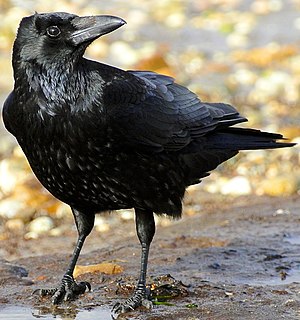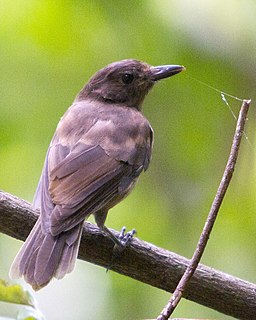Variable pitohui may refer to several species of birds:
- Northern variable pitohui, found on New Guinea and neighboring islands
- Southern variable pitohui, found on New Guinea and neighboring islands
Variable pitohui may refer to several species of birds:

The Pachycephalidae are a family of bird species that includes the whistlers, shrikethrushes, and three of the pitohuis, and is part of the ancient Australo-Papuan radiation of songbirds. Its members range from small to medium in size, and occupy most of Australasia. Australia and New Guinea are the centre of their diversity and, in the case of the whistlers, the South Pacific islands as far as Tonga and Samoa and parts of Asia as far as India. The exact delimitation of boundaries of the family are uncertain, and one species, the golden whistler, has been the subject of intense taxonomic scrutiny in recent years, with multiple subspecies and species-level revisions.

The pitohuis are bird species endemic to New Guinea. The onomatopoeic name is thought to be derived from that used by New Guineans from nearby Dorey (Manokwari), but it is also used as the name of a genus Pitohui which was established by the French naturalist René Lesson in 1831. The unitalicized common name however refers to perching birds that belong to several genera of multiple bird families. The genera include Ornorectes, Melanorectes, and Pseudorectes apart from Pitohui.

The hooded pitohui is a species of bird in the genus Pitohui found in New Guinea. It was long thought to be a whistler (Pachycephalidae) but is now known to be in the Old World oriole family (Oriolidae). Within the oriole family this species is most closely related to the variable pitohuis in the genus Pitohui, and then the figbirds.

Batrachotoxin (BTX) is an extremely potent cardio- and neurotoxic steroidal alkaloid found in certain species of beetles, birds, and frogs. The name is from the Greek word βάτραχος, bátrachos, 'frog'. Structurally-related chemical compounds are often referred to collectively as batrachotoxins. It is an extremely poisonous alkaloid. In certain frogs this alkaloid is present mostly on the skin. Such frogs are among those used for poisoning darts. Batrachotoxin binds to and irreversibly opens the sodium channels of nerve cells and prevents them from closing, resulting in paralysis. No antidote is known.

A crow is a bird of the genus Corvus, or more broadly a synonym for all of Corvus. The word "crow" is used as part of the common name of species including:

The fauna of New Guinea comprises a large number of species of mammals, reptiles, birds, fish, invertebrates and amphibians.

The rusty pitohui is a species of bird in the family Pachycephalidae. It is found throughout the lowlands of the Aru Islands and New Guinea.

The whistlers, shrike-thrushes and pitohuis are the fifty-seven species of birds from the subfamily Pachycephalinae. They are found in the Australasian, Oceanian and Indomalayan realms, but the vast majority of the species are found in Wallacea, New Guinea and Australia. Most genera are species-poor or monotypic, but Pachycephala has a considerable diversity. The genera Pachycare and Hylocitrea were previously included in the subfamily Pachycephalinae until moved to the families Acanthizidae and Hylocitreidae respectively.

A shrikethrush, also spelt shrike-thrush, is any one of five species of songbird that is a member of the genus Colluricincla. They have nondescript, predominantly brown or grey, plumage, but are accomplished singers, their calls described as "strong, mellow and beautiful." Shrikethrushes are generally insectivorous, though have been recorded eating molluscs and berries. They build cup-shaped nests in the forks of trees.

The morningbird is a songbird species in the family Pachycephalidae.

The hooded butcherbird is a species of passerine bird in the family Artamidae. It is found in New Guinea. Its natural habitat is subtropical or tropical moist lowland forest.
The piping bellbird, or crested pitohui, is a species of bird in the family Oreoicidae. It was previously placed in the family Pachycephalidae.

The white-bellied pitohui is a species of bird in the family Pachycephalidae. It is found throughout the lowlands of southern New Guinea (Lorentz River to upper Fly River.

The northern variable pitohui is a species of pitohui in the family Oriolidae. It is found on New Guinea and a number of neighbouring islands. Its natural habitat is subtropical or tropical moist lowland forests. It is also one of the few known poisonous birds.

The black pitohui is a species of bird in the monotypic genus of Melanorectes in the family Pachycephalidae. It is found throughout the highlands of New Guinea. Its natural habitat is subtropical or tropical moist lowland forests.

Oreoicidae is a newly recognized family of small insectivorous songbirds, the Australo-Papuan bellbirds. The family contains three genera, each containing a single species. The genera are Aleadryas with the rufous-naped bellbird; Ornorectes which contains the piping bellbird; and Oreoica, which contains the crested bellbird.

Pitohui is a genus of birds endemic to New Guinea. The birds formerly lumped together as pitohuis were found by a 2008 study that examined their evolutionary history on the basis of the genetic sequences to have included birds that were quite unrelated to each other. They have since been separated into other genera.

The Raja Ampat pitohui, or Waigeo pitohui, is a species of pitohui in the family Oriolidae found on the western Papuan Islands of New Guinea. Its natural habitat is subtropical or tropical moist lowland forests. It is also one of the few known poisonous birds.

The southern variable pitohui is a species of pitohui in the family Oriolidae. It is found on New Guinea and neighbouring islands. Its natural habitat is subtropical or tropical moist lowland forests. It is also one of the few known poisonous birds, it carries the toxic compound homobatrachotoxins in its feathers and skin.
Brown pitohui may refer to either of two species of passerine bird: